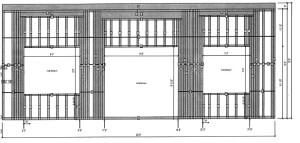
Built-up cold-formed steel compression members are commonly used as shear wall chord members, and at openings of doors and windows (stud packs) to resist the additional load transferred from an opening header. The provisions in North American Specification for the Design of Cold-Formed Steel Structural Members, AISI S100 Section D1.2 are limited to concentrically loaded compression members composed of two shapes joined together at discrete points along the axis of the member. Thus, the AISI S100 provisions are limited to either an I-shaped cross section or a box-shaped cross section.
Today there are various assumptions employed when designing the stud packs. An often employed assumption by inexperienced cold-formed steel design engineers is that each stud in a stud pack has the same tributary area as a typical wall stud. What this assumption consists of is adding studs to the stud pack equal to the number of studs displaced by an opening. Thus, the stud pack is not engineered but, in fact, is simply assembled to provide an equal number of studs as if the opening did not occur.
Another questionable assumption made by inexperienced cold-formed steel design engineers is that the axial load is shared equally to each individual member of the stud pack, and each member’s strength is based on the behavior as a discrete member. Making this assumption can lead to a suspect load path or an uneconomical, design as any synergy of the individual stud pack members is not accounted for in the design.
The following discussion introduces design concepts and practical considerations for built-up member design, for which AISI S100 and AISI framing standards, AISI S211 North American Standard for Cold-Formed Steel Framing – Wall Stud Design have specific design provisions.
